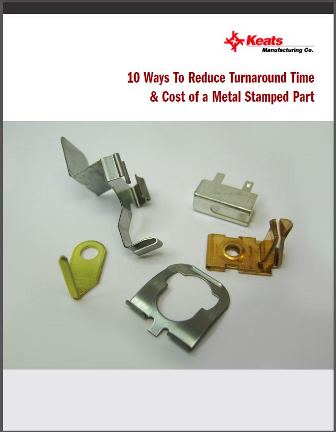At Keats Manufacturing Co., we take great pride in our dedication to our customers, especially as we design and develop stamped components, subassemblies, and other stamped solutions for various applications across a diverse range of industries. Part of that dedication involves making it easier for our customers to cost-effectively and efficiently meet their metal stamping requirements.
To that end, we’ve put together three ways to reduce turnaround time and the costs associated with fulfilling your stamping needs.
1. Use Conventional or Readily Available Materials
Currently the worldwide trend of manufacturing increasingly miniature parts is reaching the limits of the material performance. Smaller parts need to perform just as well as their larger counterparts without adding on to costs. In order to remain competitive in the global marketplace while still meeting these challenges, companies need to maximize the way they use their material.
Engineers often tend to choose an exotic metal or super alloy when faced with a high performance application. However, compensating tolerances in a design and using materials with greater than necessary strength, corrosion, or heat resistance can be very costly to the bottom line of a project.
Exotics metals and high-strength super alloys are expensive for a number of reasons, especially because of economy of scale. Many of these super alloys are not in great demand, and as a result aren’t manufactured all that often. Another factor which can add significantly to costs is the machinability of many of these materials. The harder a metal is, the more difficult it is to machine; which leads to longer cycle times  and higher tooling costs.
and higher tooling costs.
So when looking for the right materials for your next stamping project, it will be far more cost effective and timely to first choose from materials that are readily available.
2. Use Progressive Die Stamping
The ideal in manufacturing efficiency is to reduce the number of steps required. Progressive die stamping is designed to deliver these types of efficiencies and offer the opportunity for substantial cost savings. By combining basic forming processes with functions that are normally associated with downstream activities, progressive die stamping provides an overall low cost option, especially in large volumes.
3. Utilize Keats Manufacturing’s Design Expertise
Founded in 1958, Keats now has two locations, with over 142 state-of-the-art metal stamping and wire forming machines. Since then, we have built a strong reputation for quality control and enhancement, while still maintaining fair and economical pricing.
Keats’ engineering department possesses years of specialized design experience across a variety of markets and industries, including medical, aerospace and military, among countless others. The engineering team provides valuable design and planning assistance for each project, from inception to production—with the goal of providing the customer with the best part, at the best price.
Learn More in Our New eBook
For much more detail and additional suggestions for saving big and getting your product finished much faster while maintaining high quality, download our new eBook entitled 10 Ways To Reduce Turnaround Time & Cost Of A Metal Stamped Part. With comprehensive detail about a number of factors affecting various stamping processes, the eBook clearly illustrates how to quickly and cost-effectively completely your stamping project. Download your free copy today!


